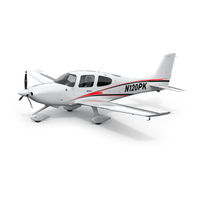CIRRUS DESIGN SR20 Manuals
Manuals and User Guides for CIRRUS DESIGN SR20. We have 3 CIRRUS DESIGN SR20 manuals available for free PDF download: Pilot Operating Handbook, Maintenance Manual
CIRRUS DESIGN SR20 Pilot Operating Handbook (508 pages)
Brand: CIRRUS DESIGN
|
Category: Aircrafts
|
Size: 13 MB
Table of Contents
-
-
Introduction11
-
The Airplane14
-
-
Introduction23
-
Fuel Limits36
-
-
Smoking40
-
-
-
-
-
Mixture60
-
Power Lever60
-
Mixture62
-
Spins67
-
-
-
Section 3A77
-
-
Introduction77
-
-
-
-
-
Before Taxiing101
-
Taxiing101
-
Before Takeoff102
-
Takeoff104
-
Normal Takeoff105
-
Climb106
-
Cruise107
-
Fuel Pump107
-
Cruise Leaning108
-
Before Landing109
-
Descent109
-
Landing109
-
After Landing111
-
Shutdown111
-
-
Note111
-
Stalls112
-
-
-
Mixture107
-
Ignition Switch114
-
Oil Pressure114
-
Power Lever114
-
Propeller Area114
-
-
-
Introduction121
-
Flight Planning122
-
Sample Problem122
-
Takeoff123
-
Climb124
-
Fuel Required126
-
Landing127
-
-
Stall Speeds134
-
Wind Components135
-
Takeoff Distance136
-
Takeoff Distance138
-
-
-
Introduction175
-
Airframe176
-
Flight Controls178
-
Elevator System178
-
Aileron System180
-
Rudder System182
-
-
Trim Systems184
-
-
Instrument Panel186
-
Center Console187
-
-
Wing Flaps204
-
Airplane Cabin206
-
Cabin Doors206
-
Seats208
-
-
Landing Gear206
-
Engine213
-
Engine Cooling213
-
Engine Exhaust215
-
Engine Controls215
-
Propeller225
-
Fuel System226
-
Brake System234
-
-
Power Generation237
-
-
-
Strobe Light245
-
Landing Light245
-
-
Reading Lights246
-
-
Pitot Heat Light251
-
-
Autopilot256
-
GPS Navigation259
-
Transponder264
-
Audio System264
-
Hour Meter266
-
Digital Clock267
-
-
-
Introduction275
-
-
Duluth, MN276
-
Ground Handling282
-
Servicing288
-
Brake Servicing288
-
Tire Inflation289
-
Oil Servicing290
-
Battery Service296
-
Carpets304
-
-
-
Introduction499
-
-
-
Deployment Speed501
-
-
-
Door Position503
-
Water Landings504
-
Ground Gusts505
-
Post Impact Fire505
-
-
Advertisement
CIRRUS DESIGN SR20 Pilot Operating Handbook (334 pages)
Brand: CIRRUS DESIGN
|
Category: Aircrafts
|
Size: 6 MB
Table of Contents
-
-
Introduction13
-
The Airplane17
-
-
Introduction27
-
-
Engine30
-
Fuel31
-
Propeller32
-
Hartzell32
-
-
-
Powerplant33
-
-
Fuel34
-
Electrical34
-
-
Fuel Limits41
-
-
Paint48
-
-
Smoking48
-
-
Placards49
-
-
-
Introduction57
-
-
Warnings57
-
-
Methodology58
-
Memory Items60
-
-
-
-
Airstart65
-
Glide70
-
-
Mixture73
-
-
Power Lever73
-
Fuel Pump73
-
-
-
Introduction97
-
Engine System102
-
OIL TEMP Caution102
-
Fuel System104
-
-
M BUS 1 Caution105
-
M BUS 2 Caution106
-
BATT 1 Caution106
-
-
Other Conditions116
-
Aborted Takeoff116
-
-
-
-
Introduction121
-
-
Engine Start128
-
Before Taxiing129
-
Taxiing130
-
Before Takeoff131
-
Takeoff133
-
Normal Takeoff134
-
Climb135
-
Cruise136
-
Cruise Leaning138
-
Descent139
-
Before Landing139
-
Landing139
-
Normal Landing139
-
-
Shutdown141
-
Stalls141
-
-
Introduction149
-
Standard Charts149
-
Wind Components164
-
Takeoff Distance165
-
Enroute Climb172
-
Balked Landing181
-
Landing Distance183
-
-
-
Airframe199
-
Introduction199
-
Flight Controls200
-
Elevator System200
-
Aileron System203
-
Rudder System205
-
Control Locks205
-
-
Instrument Panel207
-
-
Altimeter214
-
Magnetic Compass216
-
Wing Flaps216
-
Landing Gear219
-
Main Gear219
-
Nose Gear219
-
Brake System219
-
-
Seats221
-
Front Seats221
-
Rear Seats222
-
-
Cabin Doors225
-
Key Fob225
-
-
Engine225
-
Engine Controls226
-
Engine Exhaust231
-
Engine Cooling232
-
-
Propeller232
-
Fuel System233
-
Fuel Indicating236
-
Lighting Systems250
-
-
Distribution256
-
Heating256
-
Cooling256
-
Vent Selection257
-
-
Avionics264
-
Cabin Features283
-
-
-
Introduction293
-
Ground Handling298
-
Servicing303
-
Care of Graphics315
-
Carpets321
-
-
-
Introduction327
-
-
-
-
Deployment Speed331
-
-
-
Door Position332
-
Water Landings333
-
Post-Impact Fire333
-
Ground Gusts334
-
Cirrus Design SR20 Maintenance Manual (10 pages)
AIRPLANE
Brand: Cirrus Design
|
Category: Aircrafts
|
Size: 0 MB
Advertisement
Advertisement


